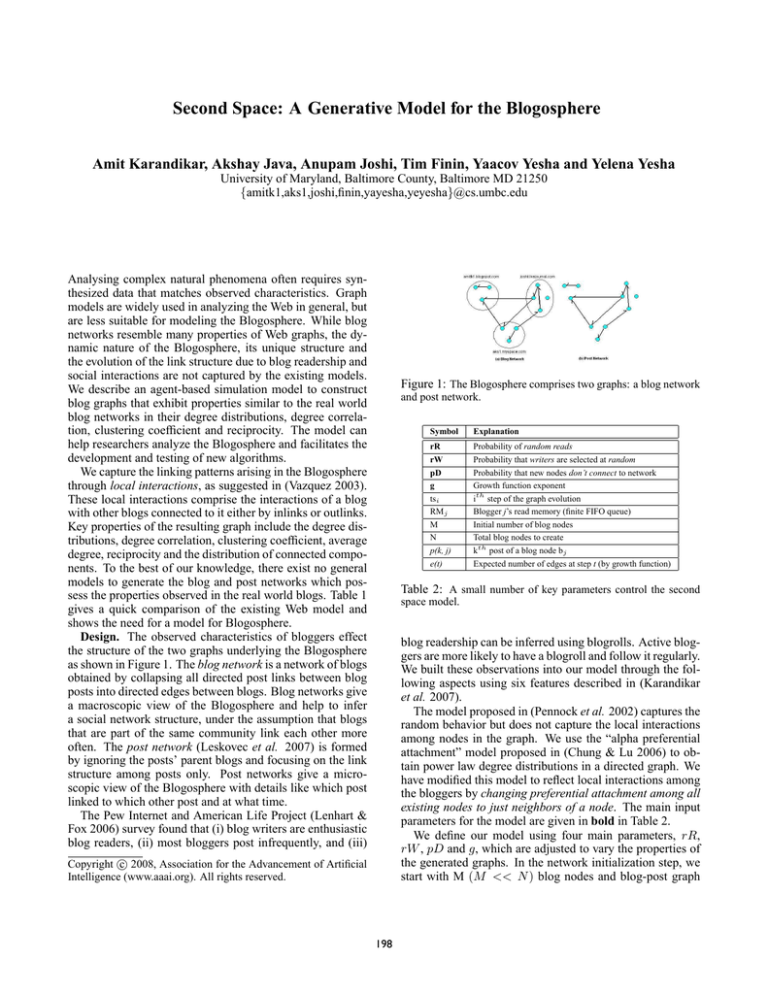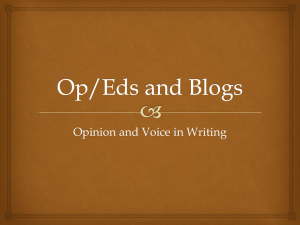
Second Space: A Generative Model for the Blogosphere
Amit Karandikar, Akshay Java, Anupam Joshi, Tim Finin, Yaacov Yesha and Yelena Yesha
University of Maryland, Baltimore County, Baltimore MD 21250
{amitk1,aks1,joshi,finin,yayesha,yeyesha}@cs.umbc.edu
Analysing complex natural phenomena often requires synthesized data that matches observed characteristics. Graph
models are widely used in analyzing the Web in general, but
are less suitable for modeling the Blogosphere. While blog
networks resemble many properties of Web graphs, the dynamic nature of the Blogosphere, its unique structure and
the evolution of the link structure due to blog readership and
social interactions are not captured by the existing models.
We describe an agent-based simulation model to construct
blog graphs that exhibit properties similar to the real world
blog networks in their degree distributions, degree correlation, clustering coefficient and reciprocity. The model can
help researchers analyze the Blogosphere and facilitates the
development and testing of new algorithms.
We capture the linking patterns arising in the Blogosphere
through local interactions, as suggested in (Vazquez 2003).
These local interactions comprise the interactions of a blog
with other blogs connected to it either by inlinks or outlinks.
Key properties of the resulting graph include the degree distributions, degree correlation, clustering coefficient, average
degree, reciprocity and the distribution of connected components. To the best of our knowledge, there exist no general
models to generate the blog and post networks which possess the properties observed in the real world blogs. Table 1
gives a quick comparison of the existing Web model and
shows the need for a model for Blogosphere.
Design. The observed characteristics of bloggers effect
the structure of the two graphs underlying the Blogosphere
as shown in Figure 1. The blog network is a network of blogs
obtained by collapsing all directed post links between blog
posts into directed edges between blogs. Blog networks give
a macroscopic view of the Blogosphere and help to infer
a social network structure, under the assumption that blogs
that are part of the same community link each other more
often. The post network (Leskovec et al. 2007) is formed
by ignoring the posts’ parent blogs and focusing on the link
structure among posts only. Post networks give a microscopic view of the Blogosphere with details like which post
linked to which other post and at what time.
The Pew Internet and American Life Project (Lenhart &
Fox 2006) survey found that (i) blog writers are enthusiastic
blog readers, (ii) most bloggers post infrequently, and (iii)
Figure 1: The Blogosphere comprises two graphs: a blog network
and post network.
Symbol
Explanation
rR
rW
pD
g
tsi
RMj
M
N
p(k, j)
e(t)
Probability of random reads
Probability that writers are selected at random
Probability that new nodes don’t connect to network
Growth function exponent
ith step of the graph evolution
Blogger j’s read memory (finite FIFO queue)
Initial number of blog nodes
Total blog nodes to create
kth post of a blog node bj
Expected number of edges at step t (by growth function)
Table 2: A small number of key parameters control the second
space model.
blog readership can be inferred using blogrolls. Active bloggers are more likely to have a blogroll and follow it regularly.
We built these observations into our model through the following aspects using six features described in (Karandikar
et al. 2007).
The model proposed in (Pennock et al. 2002) captures the
random behavior but does not capture the local interactions
among nodes in the graph. We use the “alpha preferential
attachment” model proposed in (Chung & Lu 2006) to obtain power law degree distributions in a directed graph. We
have modified this model to reflect local interactions among
the bloggers by changing preferential attachment among all
existing nodes to just neighbors of a node. The main input
parameters for the model are given in bold in Table 2.
We define our model using four main parameters, rR,
rW , pD and g, which are adjusted to vary the properties of
the generated graphs. In the network initialization step, we
start with M (M << N ) blog nodes and blog-post graph
c 2008, Association for the Advancement of Artificial
Copyright Intelligence (www.aaai.org). All rights reserved.
198
Property
ER model
BA model
Blogosphere
Simulation
Type
Degree distribution
Slope [inlinks,outlinks]
Avg. degree
Component distribution
Correlation coefficient
Avg clustering coeff.
Reciprocity
undirected
poisson
N/A
constant (for given p)
N/A (undirected)
0.00017
N/A (undirected)
undirected
power law
[2.08,-]
constant (adds m edges)
N/A (undirected)
1 (fully preferential)
0.00018
N/A (undirected)
directed
power law
[1.66-1.8,1.6-1.75]
increases
Power law
0.024 (WWE)
0.0235 (WWE)
0.6 (WWE)
directed
power law
[1.7-2.1,1.5-1.6]
increases
Power law
0.1
0.0242
0.6
Table 1: Comparing the properties of common Web models, the observed Blogosphere and our simulated Blogosphere reveals key differences.
G(V, E) such that V = M , E = {}. The read queue of all
blog nodes is empty at the start and fills as the bloggers read
existing blog-posts in the read phase. In each cycle of the
simulation, we perform steps in which simulated bloggers
read blogs until motivated to write and then write commenting on one of the blogs recently read.
Results. We compared the properties of our simulated
Blogosphere with the properties of two large blog datasets
available for researchers – WWE 2006 and ICWSM 2007.
Tables 3 and 4 summarize the properties of ICWSM and
WWE datasets and compare them with the simulated Blogosphere. We eliminated spam blogs from WWE dataset using
the techniques from (Kolari et al. 2006). The WWE dataset
was largely biased toward LiveJournal, MySpace and few
other blogs. Hence we ignored all post links to and from
these blogs. A complete interpretation and analysis of the
results is available in (Karandikar et al. 2007).
Blog network
ICWSM WWE Simulation
Total blogs
Blog-blog links
Unique links
Average degree
Indegree distribution
Outdegree distribution
Degree correlation
Diameter
Largest WCC size
Largest SCC size
Clustering coefficients
Percent Reciprocity
159,036 650,660
435,675 1,893,187
245,840 648,566
5.47
5.73
-2.07
-2.0
-1.51
-1.6
0.056
0.002
14
12
96,806 263,515
4,787
4,614
0.04429 0.0235
3.03
0.6838
Post network
ICWSM WWE Simulation
Total posts
1,035,3611,527,348 1,380,341
Post-post links
1,354,6101,863,979 1,451,069
Unique links
458,950 1,195,072 1,442,525
Avg post outlinks
1.30
1.22
1.051
Average degree
2.62
2.44
2.10
Indegree distribution
-1.26
-2.6
-2.54
Outdegree distribution
-1.03
-2.04
-2.04
Degree correlation
-0.113 -0.035
-0.006
Diameter
20
24
12
Largest WCC size
134,883 262,919 1,068,755
Largest SCC size
14
13
3
Clustering coefficients
0.0026 0.00135 0.00011
Percent Reciprocity
0.029
0.021
0.01
Table 4: Comparison of post network properties of datasets and
simulation
funding from IBM.
650,000
1,451,069
1,158,803
4.47
-1.71
-1.76
0.10
6
617,044
72,303
0.0242
0.6902
References
Chung, F., and Lu, L. 2006. Complex Graphs and Networks (Cbms Regional Conference Series in Mathematics).
Boston, MA, USA: American Mathematical Society.
Karandikar, A.; Java, A.; Joshi, A.; Finin, T.; Yesha, Y.;
and Yesha, Y. 2007. Second space: a generative model for
the blogosphere. Technical report, Univ. Maryland, Baltimore County.
Kolari, P.; Java, A.; Finin, T.; Oates, T.; and Joshi, A.
2006. Detecting spam blogs: A machine learning approach. AAAI 2006 - AI on the Web.
Lenhart, A., and Fox, S. 2006. Bloggers: A portrait of the
internet’s new storytellers. http://www.pewinternet.org/.
Pew Internet and American Life Project Survey.
Leskovec, J.; McGlohon, M.; Faloutsos, C.; Glance, N.;
and Hurst, M. 2007. Cascading behavior in large blog
graphs. In SIAM Int. Conf. on Data Mining.
Pennock, D. M.; Flake, G. W.; Lawrence, S.; Glover, E. J.;
and Giles, C. L. 2002. Winners don’t take all: Characterizing the competition for links on the web. Proceedings of
the National Academy of Sciences 99(8):5207–5211.
Vazquez, A. 2003. Growing networks with local rules:
preferential attachment, clustering hierarchy and degree
correlations. Physical Review E 67:056104.
Table 3: Comparison of blog network properties of datasets and
simulation, Parameters: rR = 0.15, rW = 0.35, pD = 0.10, g = 1.06
Conclusion. We described a generative model for blog
and post graphs that is based on the interactions among the
bloggers and uses preferential and uniform random attachment techniques. We analyzed the key resulting structural
properties, including degree distributions, degree correlations, reciprocity, average degree and clustering coefficient,
and showed a power law distribution of connected components, posts per blog as observed in (Leskovec et al. 2007).
The simulated Blogosphere will be useful to the research
community for data generation, analysis and extrapolation.
Acknowledgements. Partial support was provided by
NSF awards ITR-IIS-0326460 and ITR-IDM-0219649 and
199




